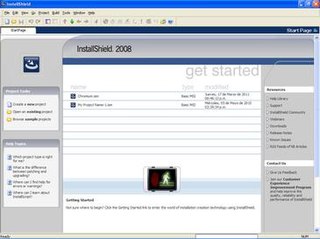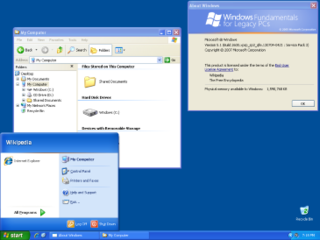
Windows XP is a major release of Microsoft's Windows NT operating system. It was released to manufacturing on August 24, 2001, and later to retail on October 25, 2001. It is a direct upgrade to its predecessors, Windows 2000 for high-end and business users and Windows Me for home users, and is available for any devices running Windows NT 4.0, Windows 98, Windows 2000, or Windows Me that meet the new Windows XP system requirements.
Virtual PC is an x86 emulator for PowerPC Mac hosts and a virtualization app for Microsoft Windows hosts. It was created by Connectix in 1997 and acquired by Microsoft in 2003. The Mac version was discontinued in 2006 following the Mac transition to Intel, while the Windows version was discontinued in 2011 in favour of Hyper-V.

In computing, a service pack comprises a collection of updates, fixes, or enhancements to a software program delivered in the form of a single installable package. Companies often release a service pack when the number of individual patches to a given program reaches a certain (arbitrary) limit, or the software release has shown to be stabilized with a limited number of remaining issues based on users' feedback and bug reports. In large software applications such as office suites, operating systems, database software, or network management, it is not uncommon to have a service pack issued within the first year or two of a product's release. Installing a service pack is easier and less error-prone than installing many individual patches, even more so when updating multiple computers over a network, where service packs are common.
Remote Desktop Protocol (RDP) is a proprietary protocol developed by Microsoft Corporation which provides a user with a graphical interface to connect to another computer over a network connection. The user employs RDP client software for this purpose, while the other computer must run RDP server software.

InstallShield is a proprietary software tool for creating installers or software packages. InstallShield is primarily used for installing software for Microsoft Windows desktop and server platforms, though it can also be used to manage software applications and packages on a variety of handheld and mobile devices.

Windows Internet Explorer 7 (IE7) is a web browser for Windows. It was released by Microsoft on October 18, 2006, as the seventh version of Internet Explorer and the successor to Internet Explorer 6. Internet Explorer 7 is part of a long line of versions of Internet Explorer and was the first major update to the browser since 2001. It was the default browser in Windows Vista and Windows Server 2008, as well as Windows Embedded POSReady 2009, and can replace Internet Explorer 6 on Windows XP and Windows Server 2003, but unlike version 6, this version does not support Windows 2000, Windows ME, or earlier versions of Windows. It also does not support Windows 7, Windows Server 2008 R2 or later Windows Versions.

Windows Fundamentals for Legacy PCs ("WinFLP") is a thin client release of the Windows NT operating system developed by Microsoft and optimized for older, less powerful hardware. It was released on July 8, 2006, nearly two years after its Windows XP SP2 counterpart was released in August 2004, and is not marketed as a full-fledged general purpose operating system, although it is functionally able to perform most of the tasks generally associated with one. It includes only certain functionality for local workloads such as security, management, document viewing related tasks and the .NET Framework. It is designed to work as a client–server solution with RDP clients or other third party clients such as Citrix ICA. Windows Fundamentals for Legacy PCs reached end of support on April 8, 2014 along with most other Windows XP editions.

Windows Vista is a major release of Microsoft's Windows NT operating system. It was released to manufacturing on November 8, 2006, and became generally available on January 30, 2007, on the Windows Marketplace, the first release of Windows to be made available through a digital distribution platform. Vista succeeded Windows XP (2001); at the time, the five-year gap between the two was the longest time span between successive Windows releases.
Open Enterprise Server (OES) is a server operating system published by OpenText. It was first published by Novell in March 2005 to succeed their NetWare product.

Windows Server Update Services (WSUS), previously known as Software Update Services (SUS), is a computer program and network service developed by Microsoft Corporation that enables administrators to manage the distribution of updates and hotfixes released for Microsoft products to computers in a corporate environment. WSUS downloads these updates from the Microsoft Update website and then distributes them to computers on a network. WSUS is an integral component of Windows Server.

SUSE Linux Enterprise (SLE) is a Linux-based operating system developed by SUSE. It is available in two editions, suffixed with Server (SLES) for servers and mainframes, and Desktop (SLED) for workstations and desktop computers.

Microsoft Expression Web is a discontinued HTML editor and general web design software product by Microsoft. It was discontinued on December 20, 2012, and subsequently made available free of charge from Microsoft. It was a component of the also discontinued Expression Studio.
Veritas Backup Exec is a data protection software product designed for customers with mixed physical and virtual environments, and who are moving to public cloud services. Supported platforms include VMware and Hyper-V virtualization, Windows and Linux operating systems, Amazon S3, Microsoft Azure and Google Cloud Storage, among others. All management and configuration operations are performed with a single user interface. Backup Exec also provides integrated deduplication, replication, and disaster recovery capabilities and helps to manage multiple backup servers or multi-drive tape loaders.

Microsoft Flight Simulator X is a 2006 flight simulation video game originally developed by Aces Game Studio and published by Microsoft Game Studios for Microsoft Windows. It is the sequel to Microsoft Flight Simulator 2004 and the tenth installment of the Microsoft Flight Simulator series, which was first released in 1982. It is built on an upgraded graphics rendering engine, showcasing DirectX 10 features in Windows Vista and was marketed by Microsoft as the most important technological milestone in the series at the time. FSX is the first version in the series to be released on DVD media.
This article is a comparison of notable business integration and business process automation software.
Windows Assessment and Deployment Kit, formerly Windows Automated Installation Kit, is a collection of tools and technologies produced by Microsoft designed to help deploy Microsoft Windows operating system images to target computers or to a virtual hard disk image in VHD format. It was first introduced with Windows Vista. WAIK is a required component of Microsoft Deployment Toolkit.
This is the version history of Internet Explorer.
Microsoft Forefront Unified Access Gateway (UAG) is a discontinued software suite that provides secure remote access to corporate networks for remote employees and business partners. Its services include reverse proxy, virtual private network (VPN), DirectAccess and Remote Desktop Services. UAG was released in 2010, and is the successor for Microsoft Intelligent Application Gateway (IAG) which was released in 2007. UAG is part of the Microsoft Forefront offering. Microsoft discontinued the product in 2014, although the Web Application Proxy feature of Windows Server 2012 R2 and later offers some of its functionalities.
Flexera is an American computer software company based in Itasca, Illinois. It is a business-focused organization which works in software asset management and cloud management.

Microsoft started development on the .NET Framework in the late 1990s originally under the name of Next Generation Windows Services (NGWS). By late 2001 the first beta versions of .NET Framework 1.0 were released. The first version of .NET Framework was released on 13 February 2002, bringing managed code to Windows NT 4.0, 98, 2000, ME and XP.









